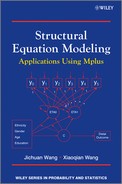Chapter 1
Introduction
The origins of structural equation modeling (SEM) stem from factor analysis (Spearman, 1904; Tucker, 1955) and path analysis (or simultaneous equations) (Wright, 1918, 1921, 1934). By integrating the measurement (factor analysis) and structural (path analysis) approaches, a more generalized analytical framework is produced, called SEM (Jöreskog, 1967, 1969, 1973; Keesling, 1972; Wiley, 1973). In SEM, unobservable latent variables (constructs or factors) are estimated from observed indicator variables, and the focus is on estimation of the relations among the latent variables free of the influence of measurement errors (Jöreskog, 1973; Jöreskog and Sörbom, 1979; Bentler, 1980, 1983; Bollen, 1989a).
SEM provides a mechanism for taking into account measurement error in the observed variables involved in a model. In social sciences, some constructs, such as intelligence, ability, trust, self-esteem, motivation, success, ambition, prejudice, alienation, and conservatism, cannot be directly observed. They are essentially hypothetical constructs or concepts, for which there exists no operational method for direct measurement. Researchers can only find some observed measures that are indicators of a latent variable. The observed indicators of a latent variable usually contain sizable measurement errors. Even for variables, which can be directly measured, measurement errors are always a concern in statistical analysis. Traditional statistical methods [e.g., multiple regressions, analysis of variance (ANOVA), path analysis, simultaneous equations] ignore the potential measurement error of variables included in a model. If an independent variable in a multiple regression model has measurement error, then the model residuals would be correlated with this independent variable, leading to violation of the basic statistical assumption. As a result, the parameter estimates of the regression model would be biased and result in incorrect conclusions. SEM provides a flexible and powerful means of simultaneously assessing the quality of measurement and examining causal relationships among constructs. That is, it offers an opportunity of constructing the unobserved latent variables and estimating the relationships among the latent variables that are uncontaminated by measurement errors.
Other advantages of SEM include, but are not limited to, the ability to model multiple dependent variables simultaneously; the ability to test overall model fit, direct and indirect effects, complex and specific hypotheses, and parameter invariance across multiple between-subjects groups; the ability to handle difficult data (e.g., time series with autocorrelated error, non-normal, censored, count and categorical outcomes), and to combine person-centered and variable-centered analytical approaches. The related topics on these model features will be discussed in the following chapters.
This chapter gives a brief introduction to SEM through five steps that characterize most SEM applications (Bollen and Long, 1993):
